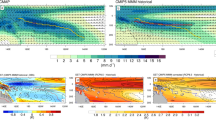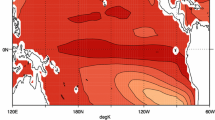Abstract
The response of the South Pacific Convergence Zone (SPCZ) to climate change is examined using simulations from 16 coupled climate models under the A2 emission scenario carried out for the Intergovernmental Panel on Climate Change Fourth Assessment Report. Characteristics of the austral summer SPCZ in the late twenty-first century are compared with the late twentieth century: the orientation and latitude of the SPCZ precipitation band; the area and intensity of precipitation within the SPCZ; and the eastern extent of the SPCZ. Changes in the SPCZ position are examined using a simple linear fit to the band of maximum precipitation and using a “pattern matching” technique. Both techniques find no consistent shift in the slope or mean latitude of the austral summer SPCZ. However, many models simulate a westward shift in the eastern edge of the SPCZ in austral summer, with reduced precipitation to the east of around 150°W. The westward contraction of the SPCZ is associated with a strengthening of the trade winds in the southeast Pacific and an increased zonal sea surface temperature gradient across the South Pacific. The majority of models simulate an increase in the area of the SPCZ and in mean and maximum precipitation within the SPCZ, defined by a 6 mm/day precipitation threshold, consistent with increased moisture convergence in a warmer climate. Changes in the SPCZ response to ENSO are examined using ENSO precipitation composites. The SPCZ has a reduced slope and is shifted towards the equator in the A2 multi-model mean El Niño composite.









Similar content being viewed by others
References
Ashok K, Behera SK, Rao SA, Weng H, Yamagata T (2007) El Niño Modoki and its possible teleconnections. J Geophys Res 112:C11007. doi:10.1029/2006JC003798
Berry G, Reeder MJ, Jakob C (2011) A global climatology of atmospheric fronts. Geophys Res Lett 38:L04809. doi:10.1029/2010GL046451
Brown JR, Power SB, Delage FP, Colman RA, Moise AF, Murphy BF (2011) Evaluation of the South Pacific Convergence Zone in IPCC AR4 climate model simulations of the 20th century. J Clim 24:1565–1582
Chou C, Neelin JD (2004) Mechanisms of global warming impacts on regional tropical precipitation. J Clim 17:2688–2701
Chou C, Neelin JD, Chen C-A, Tu J-Y (2009) Evaluating the “rich-get-richer” mechanism in tropical precipitation change under global warming. J Clim 22:1982–2005
Christensen JH, Hewitson B, Busuioc A, Chen A, Gao X, Held I, Jones R, Kolli RK, Kwon W-T, Laprise R, Magaña Rueda V, Mearns L, Menéndez CG, Räisänen J, Rinke A, Sarr S Whetton P (2007) Regional climate projections. In: Solomon S, Qin D, Manning M, Chen Z, Marquis M, Averyt KB, Tignor M, Miller HL (eds) Climate change 2007: the physical science basis. Contribution of working group I to the fourth assessment report of the Intergovernmental Panel on Climate Change. Cambridge University Press, Cambridge, United Kingdom and New York, NY, USA
Collins M, An S-I, Cai W, Ganachaud A, Guilyardi E, ** F–F, Jochum M, Lengaigne M, Power S, Timmermann A, Vecchi G, Wittenberg A (2010) The impact of global warming on the tropical Pacific and El Niño. Nat Geosci 3:391–397
De Szoeke SP, **e S-P (2008) The tropical eastern Pacific seasonal cycle: assessment of errors and mechanisms in IPCC AR4 coupled ocean-atmosphere general circulation models. J Clim 21:2573–2590
DiNezio PN, Clement AC, Vecchi GA, Soden BJ, Kirtman BP, Lee S-K (2009) Climate response of the equatorial Pacific to global warming. J Clim 22:4873–4892
Ebert EE, Gallus WA (2009) Toward better understanding of the contiguous rain area (CRA) method of spatial forecast verification. Weather Forecast 24:1401–1415
Folland CK, Renwick JA, Salinger MJ, Mullen AB (2002) Relative influences of the interdecadal Pacific oscillation and ENSO on the South Pacific Convergence Zone. Geophys Res Lett 29:1643. doi:10.1029/2001GL014201
Folland CK, Salinger MJ, Jiang N, Rayner NA (2003) Trends and variations in South Pacific island and ocean surface temperatures. J Clim 16:2859–2874
Griffiths GM, Salinger MJ, Leleu I (2003) Trends in extreme daily rainfall across the South Pacific and relationship to the South Pacific Convergence Zone. Int J Clim 23:847–869
Guilyardi E, Wittenberg A, Fedorov A, Collins M, Wang C, Capotondi A, van Oldenborgh GJ, Stockdale T (2009) Understanding El Niño in ocean-atmosphere general circulation models: progress and challenges. Bull Am Meteorol Soc 90:325–340
Hawkins E, Sutton R (2011) The potential to narrow uncertainty in projections of regional precipitation change. Clim Dyn 37: 407–418. doi:10.1007/s00382-010-0810-6
Held IM, Soden BJ (2006) Robust responses of the hydrological cycle to global warming. J Clim 19:5686–5699
Irving DB, Perkins SE, Brown JR, Sen Gupta A, Moise AF, Murphy BF, Muir LC, Colman RA, Power SB, Delage FP, Brown JN (2011) Evaluating global climate models for climate change projections in the Pacific island region. Clim Res C1028. doi:10.3354/cr01028
Juillet-Leclerc A, Thiria S, Naveau P, Delcroix T, Le Bec N, Blamart D, Corrège T (2006) SPCZ migration and ENSO events during the 20th century as revealed by climate proxies from a Fiji coral. Geophys Res Lett 33:L17710. doi:10.1029/2006GL025950
Kiladis GN, von Storch H, van Loon H (1989) Origin of the South Pacific Convergence Zone. J Clim 2:1185–1195
Kug J-S, ** F–F, An S-I (2009) Two-types of El Niño events: cold tongue El Niño and warm pool El Niño. J Clim 22:1499–1515
Lin J-L (2007) The double-ITCZ problem in IPCC AR4 coupled GCMs: ocean-atmosphere feedback analysis. J Clim 20:4497–4525
Linsley BK, Kaplan A, Gouriou Y, Salinger J, deMenocal PB, Wellington GM, Howe SS (2006) Tracking the extent of the South Pacific Convergence Zone since the early 1600 s. Geochem Geophys Geosyst 7:Q05003. doi:10.1029/2005GC001115
Linsley BK, Zhang P, Kaplan A, Howe SS, Wellington GM (2008) Interdecadal-decadal climate variability from multicoral oxygen isotope records in the South Pacific Convergence Zone region since 1650 A.D. Paleoceanography 23:PA2219. doi:10.1029/2007PA001539
Lintner BR, Neelin JD (2008) Eastern margin variability of the South Pacific Convergence Zone. Geophys Res Lett 35:L16701. doi:10.1029/2008GL034298
Liu Z, Vavrus SJ, He F, Wen N, Zhang Y (2005) Rethinking tropical ocean response to global warming: the enhanced equatorial warming. J Clim 18:4684–4700
Meehl GA (1987) The annual cycle and interannual variability in the tropical Pacific and Indian Ocean regions. Mon Weather Rev 115:27–50
Meehl GA, Covey C, Delworth T, Latif M, McAvaney B, Mitchell JFB, Stouffer RJ, Taylor KE (2007) The WCRP CMIP3 multimodel dataset: a new era in climate change research. Bull Am Meteorol Soc 88:1383–1394
Moise AF, Delage FP (2011) New climate model metrics based on object-orientated pattern matching of rainfall. J Geophys Res 116:D12108. doi:10.1029/2010JD015318
Power S, Casey T, Folland C, Colman A, Mehta V (1999) Inter-decadal modulation of the impact of ENSO on Australia. Clim Dyn 15:319–324
Salinger MJ, Renwick JA, Mullan AB (2001) Interdecadal Pacific oscillation and South Pacific climate. Int J Clim 21:1705–1721
Seager R, Naik N, Vecchi G (2010) Thermodynamic and dynamic mechanisms for large-scale changes in the hydrological cycle in response to global warming. J Clim 23:4651–4668
Streten N (1973) Some characteristics of satellite-observed bands of persistent cloudiness over the Southern Hemisphere. Mon Weather Rev 6:486–495
Sun Y, Solomon S, Dai A, Portmann RW (2007) How often will it rain? J Clim 20:4801–4818
Takahashi K, Battisti DS (2007) Processes controlling the mean tropical Pacific precipitation pattern. Part II: The SPCZ and the southeast Pacific dry zone. J Clim 20:5696–5706
Takahashi K, Montecinos A, Goubanova K, Dewitte B (2011) ENSO regimes: reinterpreting the canonical and Modoki El Niño. Geophys Res Lett 38:L10704. doi:10.1029/2011GL047364
Timmermann A, McGregor S, ** F–F (2010) Wind effects on past and future regional sea level trends in the Southern Indo-Pacific. J Clim 23:4429–4437
Trenberth KE (1976) Spatial and temporal variations of the southern oscillation. Q J R Meteorol Soc 102:639–653
Trenberth KE (1997) The definition of El Niño. Bull Am Meteorol Soc 78:2771–2777
Vecchi GA, Soden BJ (2007) Global warming and the weakening of the tropical circulation. J Clim 20:4316–4340
Vecchi GA, Soden BJ, Wittenberg AT, Held IM, Leetmaa A, Harrison MJ (2006) Weakening of tropical Pacific atmospheric circulation due to anthropogenic forcing. Nature 441:73–76
Vincent DG (1994) The South Pacific Convergence Zone (SPCZ): a review. Mon Weather Rev 122:1949–1970
Vincent EM, Lengaigne M, Menkes CE, Jourdain NC, Marchesiello P, Madec G (2011) Interannual variability of the South Pacific Convergence Zone and implications for tropical cyclone genesis. Clim Dyn 36:1881–1896. doi:10.1007/s00382-009-0716-3
Widlansky MJ, Webster PJ, Hoyos CD (2011) On the location and orientation of the South Pacific Convergence Zone. Clim Dyn 36:561–578. doi:10.1007/s00382-0871-6
Wittenberg AT, Rosati A, Lau N-C, Ploshay JJ (2006) GFDL’s CM2 global climate models. Part III: Tropical Pacific climate and ENSO. J Clim 19:698–722
**e P, Arkin PA (1997) Global precipitation: a 17-year monthly analysis based on gauge observations, satellite estimates, and numerical model outputs. Bull Am Meteorol Soc 78:2539–2558
**e S-P, Deser C, Vecchi GA, Ma J, Teng H, Wittenberg AT (2010) Global warming pattern formation: sea surface temperature and rainfall. J Clim 23:966–986
Yeh S-W, Kug J-S, Dewitte B, Kwon M-H, Kirtman B, ** F–F (2009) El Niño in a changing climate. Nature 461:511–515
Yin X, Gruber A, Arkin PA (2004) Comparison of the GPCP and CMAP merged gauge-satellite monthly precipitation products for the period 1979–2001. J Hydrometeorol 5:1207–1222
Zhang X, Lin W, Zhang M (2007) Toward understanding the double Intertropical Convergence Zone pathology in coupled ocean-atmosphere general circulation models. J Geophys Res 112:D12102. doi:10.1029/2006JD007878
Zwiers FW, von Storch H (1995) Taking serial correlation into account in tests of the mean. J Clim 8:336–351
Acknowledgments
The research discussed in this paper was conducted with the support of the Pacific Climate Change Science Program (PCCSP), a program supported by AusAID, in collaboration with the Department of Climate Change and Energy Efficiency, and delivered by the Bureau of Meteorology and the Commonwealth Scientific and Industrial Research Organisation (CSIRO). Alex Sen Gupta and Rob Colman provided helpful comments on the manuscript. The participants of the 2010 SPCZ Workshop in Apia, Samoa provided useful and stimulating discussion. We also thank two anonymous reviewers for their comments. We acknowledge the modelling groups, the Program for Climate Model Diagnosis and Intercomparison (PCMDI) and the WCRP’s Working Group on Coupled Modelling (WGCM) for their roles in making available the WCRP CMIP3 multi-model dataset. Support of this dataset is provided by the Office of Science, U.S. Department of Energy.
Author information
Authors and Affiliations
Corresponding author
Electronic supplementary material
Below is the link to the electronic supplementary material.
Rights and permissions
About this article
Cite this article
Brown, J.R., Moise, A.F. & Delage, F.P. Changes in the South Pacific Convergence Zone in IPCC AR4 future climate projections. Clim Dyn 39, 1–19 (2012). https://doi.org/10.1007/s00382-011-1192-0
Received:
Accepted:
Published:
Issue Date:
DOI: https://doi.org/10.1007/s00382-011-1192-0




